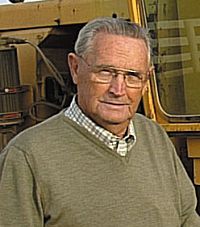Charles E. “Chuck” Coon, 86, dies
January 30, 2015,from harnessracing.com
Lexington, KY — Hall of Famer Charles E. “Chuck” Coon, 86, died Jan. 30, 2015, in Oxford, Mich., after a short illness.
Mr. Coon became harness racing’s premier innovator in racetrack design, construction and maintenance, and starting gates during his 40-plus year career in harness racing. He adopted such cutting-edge design features as super-elevated curves, which addressed both equine safety and competitive racing at a time when the focus was solely on speed. As the speed rapidly increased, the need for banking continued. Mr. Coon lobbied racetrack managers around the country and eventually rebuilt the majority of the harness tracks in North America.

Charles E. “Chuck” Coon
The tracks Mr. Coon designed became known for their elevated curves; the ones he maintained earned appreciation from horsemen for their design and cushion.
“My father (trackman Charlie Coon) taught me the importance of cushion,” said Mr. Coon in his 2008 Hall of Fame induction speech. “Some people confuse fast with hard….”
Born on May 15, 1928, in Detroit, Mich., Mr. Coon is the son of the late Charles J. Coon, a skilled trackman in his own right. After a two-year stint in the U.S. Army, he married, started a family, and began working in racetrack maintenance. He and his father were the first to put sand on a clay racetrack, thus enabling horses to race rain or shine.
Mr. Coon was working at a track in Jackson, Mich., when Pat Provenzano, the president of Batavia Downs, hired him to be the track superintendent. His expertise resulted in horses regularly going 2:00 miles on the weekends, a display of speed previously unseen at Batavia.
After his success in Batavia, he became the track superintendent at Buffalo Raceway. During this time, he obtained a starter’s license and became the starting judge at the western New York tracks. Eventually he was appointed the starter at Yonkers Raceway.
After the death of his father in 1970, Mr. Coon returned to Detroit as the starting judge at Wolverine and Hazel Park. During this period, he began to question the USTA’s protocol that called for track turns to be elevated one-inch for every foot out from the rail. Stan Bergstein introduced Mr. Coon to a Swedish professor of engineering, Dr. Ingvar Frederickson. Dr. Frederickson had performed scientific studies on the detrimental effect of horses traveling over a poorly elevated racetrack. Mr. Coon agreed with Dr. Frederickson that improper racetrack design placed undue stress on horses.
Mr. Coon soon had the opportunity to put these new ideas into practice at Buffalo Raceway. He banked the turns 12 percent, which resulted in record-breaking performances. Next he went to Windsor Raceway, removed the synthetic Tartan track (which was believed to cause lameness), and elevated the turns to 16 percent. Direct Scooter then went a mile in 1:54.2 at Windsor, a world race-record for 4-year-old pacers on a five-eighths-mile track.
In 1975, for the very first time, the Hambletonian was to be telecast live from Du Quoin on network television. Mr. Coon was retained by Fred Van Lennep and Bill Hayes to ensure that the race went off on time regardless of weather. Eventually the success at Du Quoin prompted Col. H. Willis Nichols, George Alexander, P.J. Baugh and eventually Tom Crouch to join Van Lennep and Hayes in retaining Mr. Coon to look after the clay racetracks, not only at Du Quoin but also in Springfield, Indianapolis, and The Red Mile.
Mr. Coon was always eager to point out the difference between a hard and fast track. It was not uncommon to see him talk about track conditions with horsemen, and he was involved in last-minute discussions with Clint Galbraith before Niatross scorched The Red Mile to make sure the track was conducive to the world record mile.
Mr. Coon was always quick to embrace changes he thought would help racing. After visiting Dr. Frederickson in Europe and witnessing racing without an inside hub rail, he began to promote the removal of rails in North America. As a starting judge, he experienced the challenge of providing a consistent speed to the drivers trying to get their horses away on gait. This led to the development of a computerized speed control. He also introduced the slanted starting gate at the Meadowlands.
Mr. Coon’s sons, Greg and Dan, joined their father in business and have continued his work. Mr. Coon’s brother, Jerry, also served an apprenticeship in Michigan and traveled all over North America during his career in track maintenance.
Since his retirement, Mr. Coon has followed the work of his sons, Greg and Dan, and made annual pilgrimages to Goshen, N.Y., for Hall of Fame weekend and to the Little Brown Jug. For many years he continued to make an annual trek to his hometown of Croswell, Mich., to prepare the local track for fair racing on a volunteer basis.
Mr. Coon is survived by his wife, Beverly; sons, Greg (Lynette) and Dan (Kathy Parker); daughters, Jeannine (Philipp) Weinschrod and Shelly (Mike) Gambino; grandchildren, Peter (Melanie), Michael (Heather), Nick (Meghan) Gambino, Megan (Ryan) Reese, Caitlin Cullen and Erin Cullen; eight great-grandchildren; brothers, Tom (Denise) and retired trackman Jerry (Audrey); sister, Joan (Dan) Deary; and two sisters-in-law, two brothers-in-law, and many nieces and nephews.
Visitation will take place on Tuesday (Feb. 3) from 2-4 p.m. and 6-8 p.m. at the Elton Black and Son Funeral Home, 3295 E. Highland Rd., Highland, MI 48356, with a funeral Mass at 10:30 a.m. on Wednesday (Feb. 4) at St. Perpetua Catholic Church, 134 Airport Rd., Waterford, MI 48327.
In lieu of flowers, memorial contributions may be made to the following 501c(3) entities: the Harness Racing Museum & Hall of Fame, 240 Main St., Goshen, NY 10924; Goshen Historic Track, 44 Park Place, Goshen, NY 10924, a National Historic Landmark; or Open Door Outreach Center, 7170 Cooley Lake Rd., Waterford, MI 48327.
